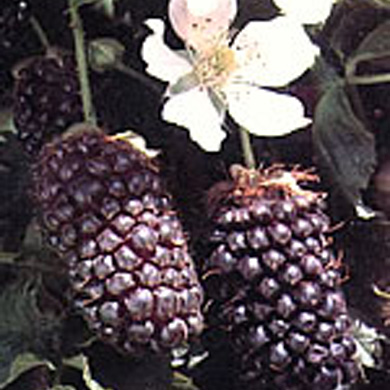Boysenberry Plants - Gardening Advice and Tips
 The Boysenberry vine (Rubus ursinus x idaeusare) is believed to be a cross between loganberry, blackberry and raspberry vines. They were developed by a farmer named Rudolph Boysen in Southern California. Later Walter Knott took up care of the new plants and eventually his farm became renowned for its restaurant, boysenberry pies and finally the preserves that turned Knott's Berry Farm into the successful theme park it is today. But boysenberries remain a wonderful fruit to be grown in the garden.
The Boysenberry vine (Rubus ursinus x idaeusare) is believed to be a cross between loganberry, blackberry and raspberry vines. They were developed by a farmer named Rudolph Boysen in Southern California. Later Walter Knott took up care of the new plants and eventually his farm became renowned for its restaurant, boysenberry pies and finally the preserves that turned Knott's Berry Farm into the successful theme park it is today. But boysenberries remain a wonderful fruit to be grown in the garden.
As landscape plants, boysenberry vines are great for covering fences and large areas you might want to mask, like tree trunks or undesirable views. They can easily send up long graceful branches to 8' in length, so if you want to use them as a screen, they are best tied in place to keep them from sprawling on the ground too much The fruit is great eaten fresh or used for canning, freezing, jelly and syrup. It is rich in vitamin C, calcium, fibre, folic acid, manganese and antioxidants, iron and even has a fair amount of potassium.
Boysenberries are rambling brambles. They will send out long wandering branches called 'canes'. It is best to provide them walls or fences to sprawl over to keep the fruit clean and make them look attractive. Wear gloves when working with thorned varieties, as they are very prickly to handle. There are also thornless varieties available.
Plant boysenberries about 3 feet apart in full sun and in soil with plenty of organics dug in. Water them in thoroughly and mulch the surface of the soil. They like to be slightly moist, but dry out somewhat between watering.
Boysenberries are considered floricane fruiting, meaning that they only produce fruit on floricanes, or canes that grew during the previous years summer. Boysenberries should be pruned carefully in the late fall or early winter, by cutting off and removing all of the floricanes at gound level. Floricanes will generally be brown or grey and much thicker and woodier than the younger primocanes which will be thinner and green. When all the floricanes are removed, thin the primocanes so only 5-7 strong canes remain per plant. On the remaining primocanes trim all lateral branches (branches coming off of the main cane) down to about 10-12 inches in length. During the spring and summer regularly tip new primocanes growth as they reach the top of wire or trellis systems. This will cause the cane to form lateral branches and boost the fruit yield the following summer. During any season if any growth appears damaged or diseased, remove and discard it immediately
Boysenberries require soil that is rich in organic matter. After pruning in the late fall or early winter, top dress the boysenberry with a thin layer of seasoned manure (well-rotted) or compost. For cooler climates, spring is the best planting time. They usually fruit in the late spring or early summer and it is a good idea to cut the older canes right back to the ground after fruiting. Boysenberries are usually cold tolerant to around 20'F, though with mulch, can take an occasional colder spell.

